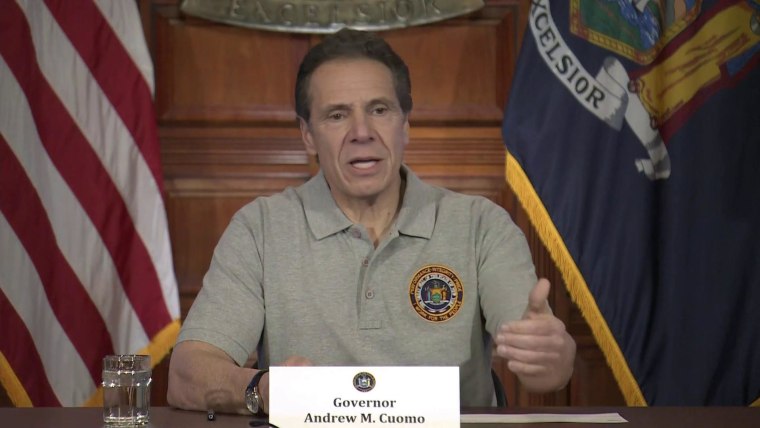Hoping to stem the toll of the state’s surging coronavirus outbreak, New York health officials plan to begin collecting plasma from people who have recovered and injecting the antibody-rich fluid into patients still fighting the virus.
Gov. Andrew Cuomo announced the plans during a news briefing Monday. The treatment, known as convalescent plasma, dates back centuries and was used during the flu epidemic of 1918 — in an era before modern vaccines and antiviral drugs.
Some experts say the treatment, although somewhat primitive, might be the best hope for combating the coronavirus until more sophisticated therapies can be developed, which could take several months.
“There have been tests that show when a person is injected with the antibodies, that then stimulates and promotes their immune system against that disease,” Cuomo said. “It’s only a trial. It’s a trial for people who are in serious condition, but the New York State Department of Health has been working on this with some of New York’s best health care agencies, and we think it shows promise, and we’re going to be starting that this week.”
New York has seen a dramatic rise in coronavirus cases in recent days, with about 20,000 confirmed cases and more than 150 deaths as of Monday afternoon, more than in any other state.
State health officials said they expect to get approval from the Food and Drug Administration to begin the plasma trial in the coming days. A spokesman for the FDA confirmed to NBC News that the agency is “working expeditiously to facilitate the development and availability” of convalescent plasma. And at a White House briefing last week, FDA Commissioner Stephen Hahn singled out the treatment as a promising option to fight the disease in the near term.
Let our news meet your inbox. The news and stories that matters, delivered weekday mornings.
“That’s great news,” said Dr. Arturo Casadevall, an infectious disease expert at the Johns Hopkins Bloomberg School of Public Health, who has been calling for widespread use of convalescent plasma. “When we started talking about this a few weeks ago, it was just an idea, and now it seems it’s going to become a reality.”
Full coverage of the coronavirus outbreak
The method — essentially harvesting virus-fighting antibodies from the blood of previously infected patients — dates back more than a century, but it has not been used widely in the United States in decades. Infusions of convalescent plasma were associated with milder symptoms and shorter hospital stays for some patients during the 2002 SARS outbreak, and initial reports from China suggest convalescent plasma might also be effective in dulling the effects of COVID-19, the disease caused by the coronavirus.
The treatment is not without risks. There is danger in giving a patient the wrong type of blood or inadvertently transmitting other pathogens in a transfusion, but safety advancements over the past two decades have made adverse outcomes rare.
In New York, health officials said they plan to begin recruiting patients who have fully recovered from COVID-19 in the coming days. That effort, officials said, would likely start in New Rochelle, the New York City suburb that was the center of the state’s initial outbreak a few weeks ago, because of the concentration of people there who have already recovered.
Potential donors would first need to undergo tests to ensure that they are no longer contagious and to confirm that their blood contains the antibodies needed to fight the disease, state health officials said. After that, donors would go to a local blood bank to give plasma — the liquid part of blood left once cells and platelets have been removed — although the state is still working out logistical details.
New York will begin by offering the treatment only to critically ill patients. But, experts said, once it is proven safe and effective, the treatment will likely work best if given to patients before symptoms become too severe. Casadevall said past studies indicate that proactive infusions of convalescent plasma might also be effective in protecting front-line health care workers from becoming seriously ill.
Similar efforts are underway across the country as hospitals scramble to prepare for an onslaught of critically ill COVID-19 patients, similar to what’s happened in New York and Seattle.
Download the NBC News app for full coverage of the coronavirus outbreak
Doctors from nearly two dozen hospitals have joined the Johns Hopkins-led effort, Casadevall said, including researchers at the Mayo Clinic in Minnesota, the Stanford University Medical Center in California and the Albert Einstein College of Medicine in New York. The researchers have been in contact with the FDA through the weekend, he said, and they hope to launch clinical trials similar to the one in New York in the coming weeks.
Michael Felberbaum, an FDA spokesman, said the agency could not comment on specific COVID-19 clinical trials. But he confirmed that the agency was working to facilitate the use of convalescent plasma.
“The agency is actively engaging with researchers to discuss the possibility of collaboration on the development of a master protocol for the use of convalescent plasma, with the goal of reducing duplicative efforts,” Felberbaum said.













